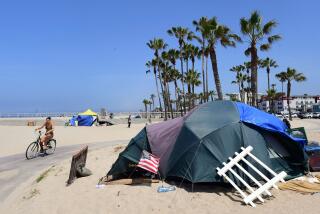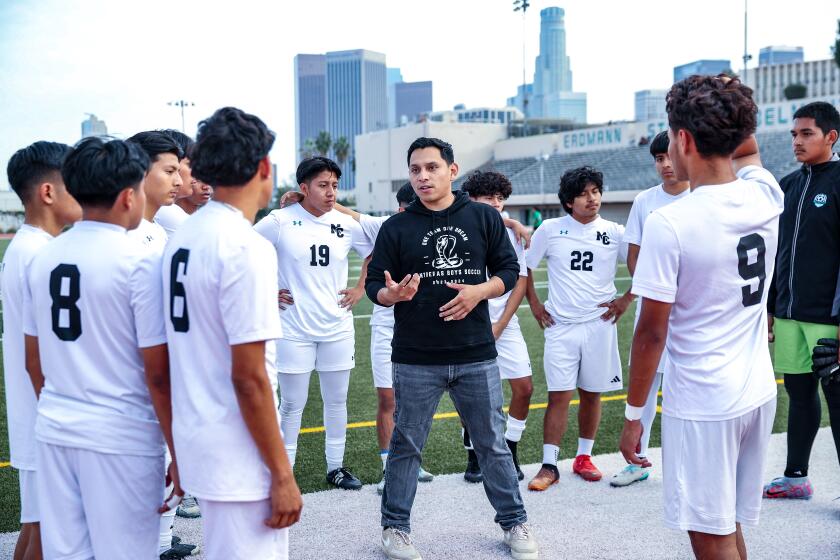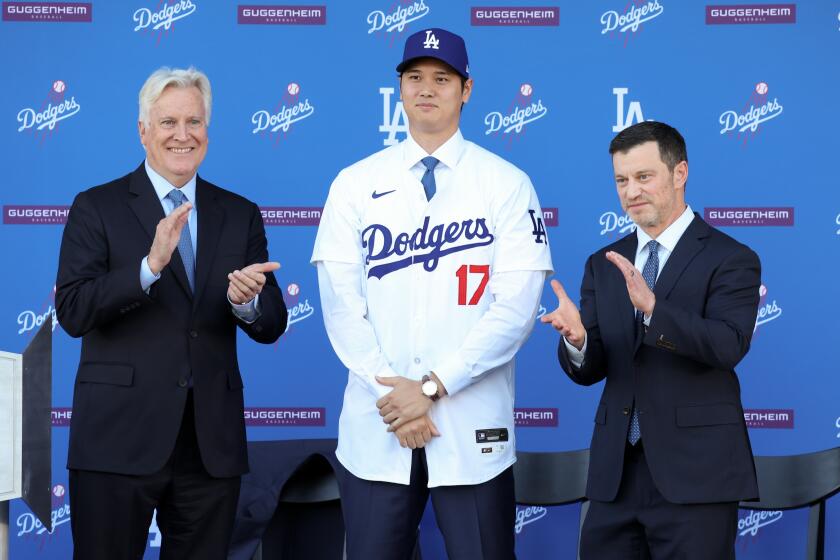Recycling a Battered Career : An Arduous Road to Recovery Lies Ahead for Topanga Rider
- Share via
Reclining on a couch in her rustic Topanga home, Casey Patterson removes a rubbery brace from her left leg, exposing a badly damaged knee.
“It’s atrophied, swollen and misshapen,” says Patterson, a 44-year-old divorced mother of three. “This is a knee that’s going to cross the country on a bicycle?”
That’s the big question for Patterson, one of the world’s premiere long-distance cyclists. A year ago, she won the women’s division of the 3,117-mile Race Across America. On April 6, as she trained on Pacific Coast Highway for this year’s race, a pickup truck slammed into her and nearly ended her life, not to mention her cycling career.
“My helmet was crushed,” she says, “and I’m convinced it saved my life.”
As it was, she suffered a broken clavicle and shoulder blade, broken ribs and a fractured left ankle. The most serious injury was to her left knee: The tibia platform was fractured and the connective tissue torn. To repair the damage, the surgeon, Dr. Todd Grant, inserted five steel screws and two staples during a 2 1/2-hour operation at Santa Monica Hospital Medical Center.
“Look at the X-ray,” Patterson says, holding it up to the light. “They used all different size screws. It looks like something I did myself.” Then she jokes about having to bring her X-rays to get through airport metal detectors.
Patterson can laugh at the irony of the injury: She won the RAM in a record 11 days, 21 hours and 15 minutes “without so much as a flat tire.” Then, several miles from home, near Kanan Dume Road, she was rammed by a driver who, despite Patterson’s bright blue jersey, didn’t see her coming the other way and sped through the intersection.
Patterson’s rehabilitation--made even more arduous because of her other broken bones--began almost immediately after surgery as she lay in the hospital. But her emotions needed patching, too.
“I was devastated,” she says. “I had no idea what injuries like these can do to your whole system. I felt I was going to die. It was awful.”
After two weeks, she was able to return home, where a hospital bed had been set up in her living room. Therapy to increase flexibility to the knee was slow and painful.
“It helped that I had been in great condition,” she says, but still, progress was measured in fractions of an inch.
“The pain and frustration were excruciating,” she says. “I had to will myself to move and to ignore the pain. Aside from pregnancy, I’d never been so involved in the workings of my body.” But when her body didn’t respond as quickly as she hoped, she would slip into a “bottomless depression.”
Patterson and her therapist, Calabasas chiropractor Dr. Laurence D. Grogin, worked toward the goal of her making a token ride in this year’s RAM, which began June 19 in San Francisco. “We made an enormous effort,” she says. “I wanted to lead that parade. But we didn’t make it.”
Immobility prevented her from pedaling her own bike, but she was able to sit on a special tandem bike behind Lon Haldeman, a top male rider, and make an appearance at the opening ceremonies.
Grogin, she says, predicts that Patterson will be able to compete in RAM in two years, but Patterson remains skeptical. Still severly hobbled almost four months since the accident, Patterson didn’t begin riding solo again until recently. Accompanied by roller-skating friend Jonathan Seutter, Patterson surprised herself by circling the 3 1/2-mile bike path at Balboa Park on her new 10-speed bicycle.
“I would have been happy to go 100 yards,” says Patterson, who was forced to lean to one side of the bike to accommodate her bad knee. “The ride was more painful--but easier--than I thought it would be.”
How did she feel afterward? “Like it’s the beginning of becoming a whole person again,” she says.
Although the knee became swollen after the ride, Patterson will ride two or three times a week on flat land “until I can kill the pain. It will take a year just to get to where I’ll know whether I can train for RAM.”
She thinks she’ll be able to walk normally; although the knee joint will never be the same, the surrounding muscles will become stronger and compensate, she says.
The psychological scars will take time to heal, too.
“I’m a little scared,” she says. “I have a fear of someone coming out of nowhere and nailing me. I don’t know what to do about that.”
Unable to race, Patterson has lost sponsors and revenue, but she isn’t going to rush her recovery. “I’m more concerned with the quality of my life than another race,” she says. “I want to heal completely.”
More to Read
Go beyond the scoreboard
Get the latest on L.A.'s teams in the daily Sports Report newsletter.
You may occasionally receive promotional content from the Los Angeles Times.










